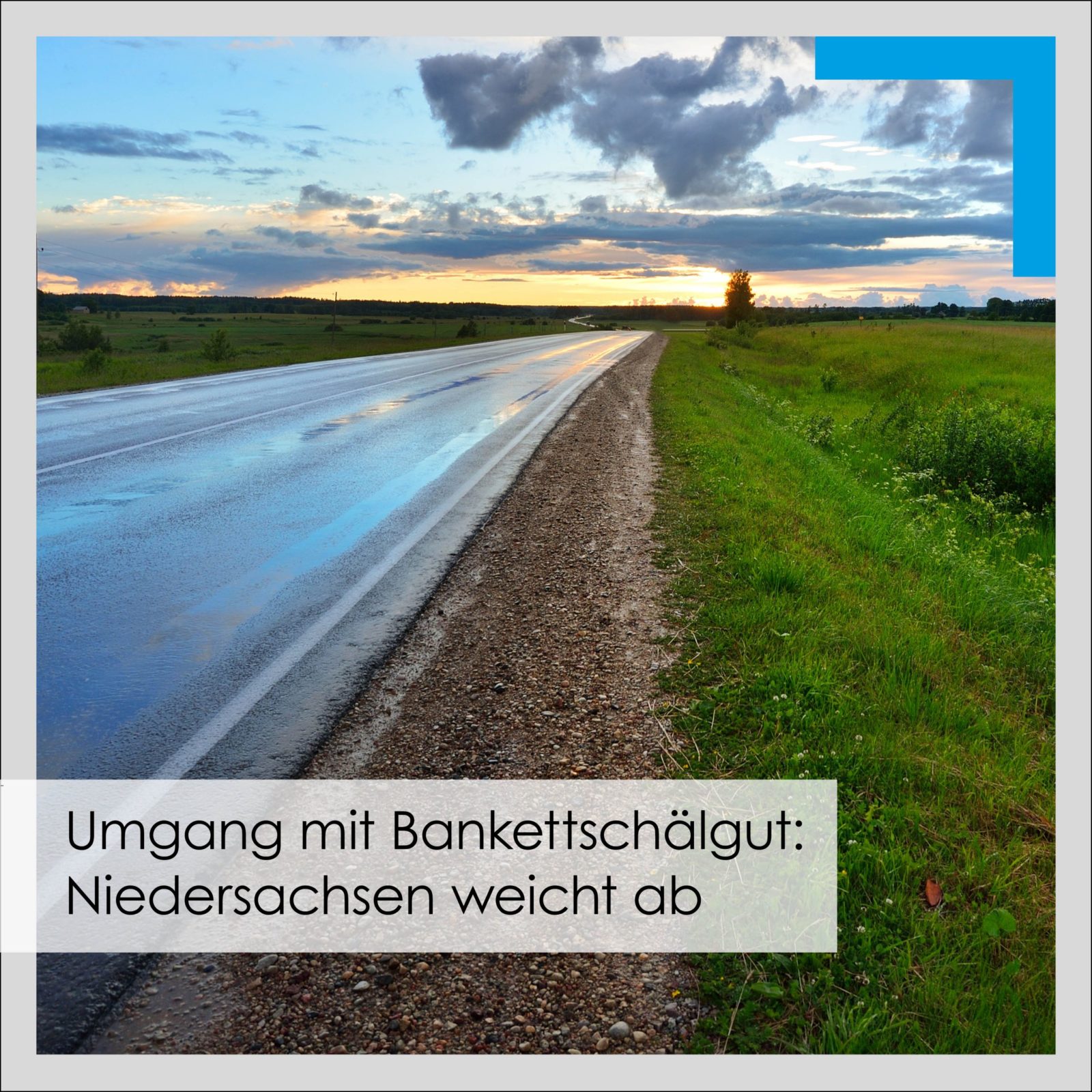Dealing with banquet peelings: Lower Saxony deviates
Staying in the roadside area prohibited
Bankettschälgut is mineral waste that is peeled off from the (un)paved area of the road body running parallel to the road in order to ensure water drainage from the roadway. In Lower Saxony, it is not permissible to relocate thin layers of peeled material for the purpose of reprofiling. When (re)applying banked material to the road shoulder or moving and dumping banked material into the road shoulder, the requirements of Section 7 (3) KrWG for proper recycling are generally not met. Lower Saxony is thus enforcing a position that goes against nationwide practice. The Lower Saxony Ministry for the Environment, Energy and Climate Protection (MU) rules out a direct implementation of the nationwide "Guideline on the Handling of Roadside Waste" in Lower Saxony.
Justification: The application of banquet peelings is not necessary and only serves the purpose of discarding. Systematic reprofiling would otherwise not be carried out. Therefore, the banquet peeling material does not replace any raw materials that would otherwise have been used for this purpose.
Banquet peelings consist of
- natural mineral raw materials with grain sizes up to 45 mm,
- Mixtures of natural aggregate and mineral waste,
- foreign matter from road use (abrasion, dust) and
- different levels of organic matter in the vegetation.
Bankbed cuttings are to be classified as waste. In principle, there is a need to investigate the suitability of peeled material for reuse. DIN 19731, section 5.2 d "Investigation of the suitability of soil for reuse" states:
"A need for investigation exists in particular for soil material of the following origins, (...)
- (d) topsoil in the roadside area, including roadbed peeling material, at least up to 10 m from the edge of the carriageway ...".
Depending on the results of the investigation, peeled banquet material is to be assigned to one of the two waste codes:
- 17 05 03* soil and stones containing dangerous substances or
- 17 05 04 Soil and stones other than those mentioned in 17 05 03.
In 2010, the Federal Ministry of Transport, Building and Urban Affairs (BMVBS) published the "Guideline on the handling of roadbed peeling material, 2010 edition", which was agreed with the Federal Ministry for the Environment, Nature Conservation and Nuclear Safety (BMU), in the General Circular on Road Construction (ARS) No. 04/2010 of 20 March 2010 (Ref.: StB 16/243.7/10-10/11715439). Enforcement is the responsibility of the Länder.
In Lower Saxony, the Ministry of the Environment and the Ministry of Transport agreed on a number of amendments that were introduced in Lower Saxony by decree of 5 November 2012 (ref.: 42.2-31601/1500) as a supplement to the directive at federal level.
Justification: The application of banked peelings is not necessary and only serves the purpose of discarding. Systematic reprofiling in thin layers would not be carried out if no mineral waste were available. Therefore, the banquet peeling material does not replace any raw materials that would otherwise have been used for this purpose. Evidence for the suitability of banquet peeling material applied in thin layers for the sustainable safeguarding or restoration of at least one of the soil functions specified in § 2 para. 2 nos. 1 and 3 letters b and c BBodSchG (see § 12 para. 2 BBodSchV) has not yet been provided.
However, roadbed peeling material can be used in the context of road construction measures if it is functionally suitable and complies with the permissible pollutant contents. Otherwise, the banquet peeling material must be handed over to a third party. In general, the following disposal options are available for banquet peeling material:
- Utilisation in the rootable soil layer on the basis of § 12 BBodSchV and the LABO implementation aid on § 12 BBodSchV,
- Utilisation in soil-like applications and technical structures on the basis of the Technical Rule on Soil (2004),
- Recovery in surface mining on the basis of the Technical Rules of the Länder Committee on Mining (LAB) (2004),
- Recycling in the recultivation layer of landfills on the basis of the Landfill Ordinance (DepV),
- Recovery and disposal at landfills on the basis of the Landfill Ordinance (DepV).
#mullandpartner #engineeringforabettertomorrow #news #bankettschaelgut #lower Saxony #pollutants #waste #road construction
Business areas
Environmental and geotechnical engineering
Construction and project management
Renewable energies
Real estate development
Infrastructure
Water management
Societies
M&P Engineering Company
T&P Beratende Ingenieure
P&P Real Estate Consulting
P&B Real Estate Management
P&M Project Management
M&P Umwelttechnik
Contact

